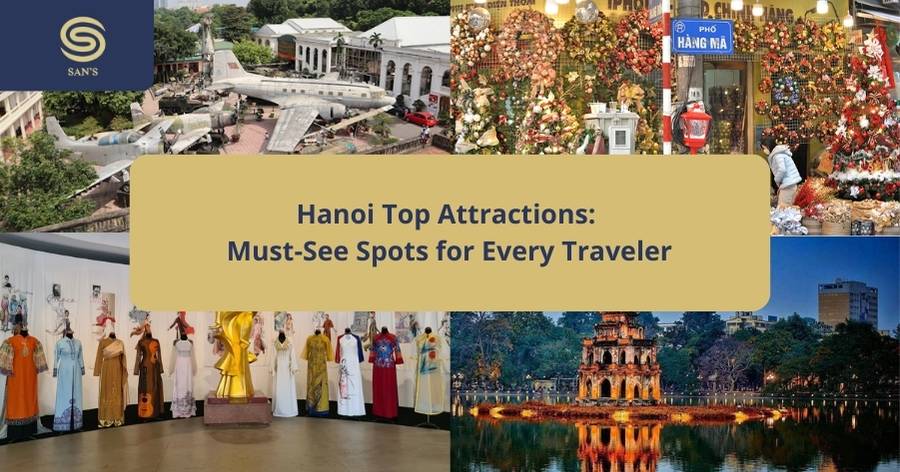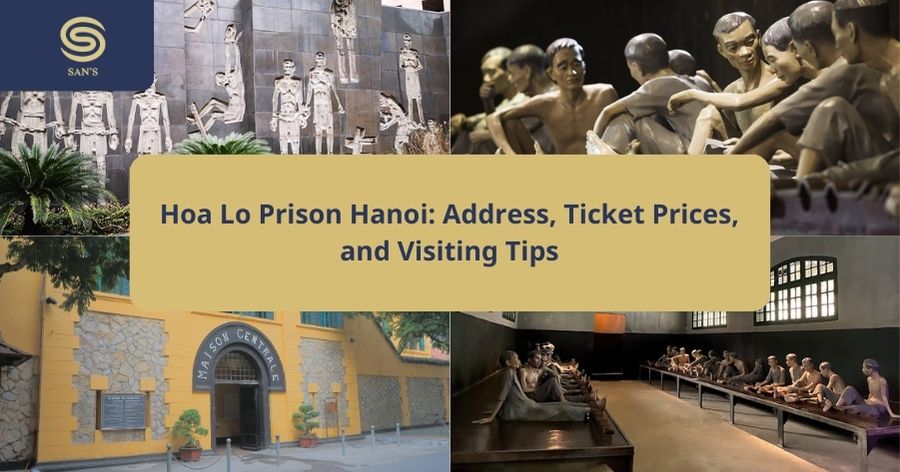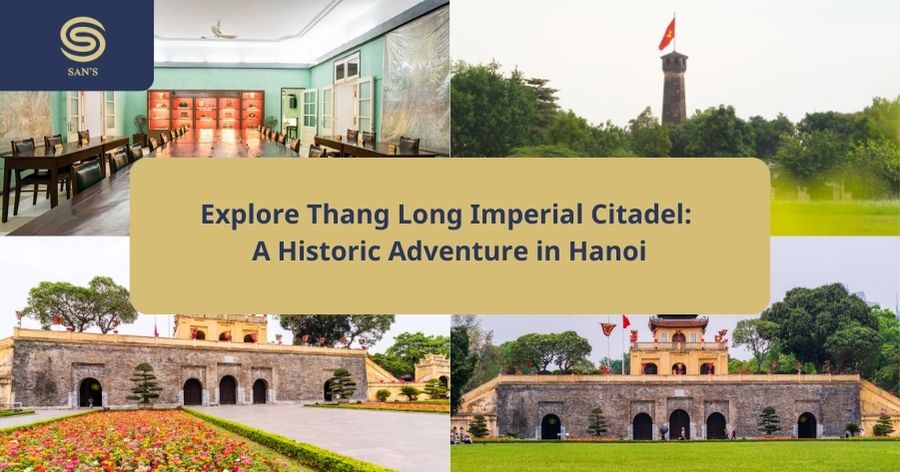Hanoi is famous for its wonderful combination of history and modernity. With its ancient streets, classic French architecture, and countless historical sites, Hanoi is an ideal destination for all travelers. Here Sanhotelseries will give you a list of Hanoi top attractions that you cannot miss when visiting this city.
1. Old Quarter
Hanoi’s Old Quarter is often regarded as the cultural and historical heart of the city, with 36 streets each dedicated to an ancient trade. Strolling through these narrow, bustling streets gives visitors a glimpse into the past, where craftsmen and traders flourished. Today, the Old Quarter is a lively blend of old-world charm and modern vibrancy. Streets such as Hang Dao, Hang Bac, and Hang Ma are emblematic of this bustling area.
Visitors can immerse themselves in local culture, savor iconic street foods like pho, bun cha, banh cuon and shop for handicrafts and traditional souvenirs. The Old Quarter is also a hub of commerce, where you’ll find an array of handcrafted goods, art pieces, and unique mementos that represent the local craftsmanship of Hanoi.

2. Temple of Literature – Quoc Tu Giam
The Temple of Literature is one of Vietnam’s most edited historical and cultural sites. Established in the 11th century, it serves as a tribute to Confucius and the scholarly traditions of the country. Temple of Literature – Quoc Tu Giam is not just a monument; it’s a symbol of Vietnamese intellectual heritage and the country’s oldest university.
Here, visitors can explore ancient courtyards, beautiful traditional architecture, and stone steles inscribed with the names of scholars. The Temple of Literature also hosts cultural events, making it a must-see for tourists seeking to understand Vietnam’s Confucian history and traditional educational values. Visitors will appreciate the serene surroundings and peaceful gardens, providing a quiet retreat from the bustling city streets.

3. Hoa Lo Prison (Nha Tu Hoa Lo)
Hoa Lo Prison, initially built by the French in the late 19th century, offers a somber insight into Vietnam’s colonial past and struggle for independence. Known as the “Hanoi Hilton” during the Vietnam War, this place used to be a place to detain and torture patriotic soldiers and leaders. Today, it serves as a museum where visitors can delve into the dark history of the prison and the resilience of the Vietnamese people.
Through the exhibits, tourists can explore the harsh conditions faced by Vietnamese revolutionaries who were imprisoned here during the French colonial period and understand the hardships endured by heroes of war. Hoa Lo is not just a historical site, but a testament to Vietnam’s fight for freedom and independence.

4. Lake of the Restored Sword (Hoan Kiem Lake)
Hoan Kiem Lake , also known as Sword Lake (Ho Guom) is the spiritual symbol of Hanoi. The lake is deeply embedded in local legend, where it is said that King Le Loi returned a magical sword to a divine turtle after defeating foreign invaders. The peaceful atmosphere of the lake, with its iconic Turtle Tower standing proudly in the middle, makes it a popular destination for both locals and tourists.
Every morning, Hanoians gather around the lake for exercise, while the serene surroundings of Ngoc Son Temple and the historic red The Huc Bridge provides a tranquil escape in the heart of the city. Hoan Kiem Lake is also a popular spot for cultural events, leisurely walks, and people-watching.

5. Vietnam Museum of Ethnology
The Vietnam Museum of Ethnology is dedicated to showcasing the rich cultural diversity of Vietnam’s 54 ethnic groups. Visitors can explore a vast collection of traditional clothing, artifacts, and models of ethnic houses, offering a deep insight into the unique customs and lifestyles of each group.
Additionally, visitors can participate in interactive activities, attend exhibitions, and enjoy performances like traditional water puppetry , adding to the cultural experience. The museum also features an outdoor section, where life-sized models of traditional homes stand, allowing visitors to walk through and experience the daily lives of Vietnam’s ethnic communities.

6. Ho Chi Minh Mausoleum – Hanoi top attractions
Ho Chi Minh Mausoleum is an essential pilgrimage site for both locals and tourists visiting Hanoi. Located in Ba Dinh Square , the mausoleum is the final resting place of President Ho Chi Minh , the leader who led Vietnam’s struggle for independence. The structure itself is imposing, standing as a symbol of the nation’s respect for its founding father.
Visitors are welcome to pay their respects in the solemn atmosphere of the mausoleum, where Ho Chi Minh’s embalmed body lies. Afterward, tourists can explore the vast Ba Dinh Square , the historic site where Ho Chi Minh proclaimed Vietnam’s independence in 1945, marking the beginning of the Democratic Republic of Vietnam.

=> See more: Free Walking Tour Hanoi Guide for Independent Travelers
7. Vietnamese Women’s Museum
The Vietnamese Women’s Museum is a must-visit destination for those intrigued by the profound role women have played throughout Vietnamese history. The museum highlights the bravery and resilience of women, particularly during wartime, shedding light on their contributions to the country’s independence and national defense. Visitors will find exhibitions detailing women’s involvement in various sectors, including their roles as soldiers, farmers, and leaders.
Additionally, the museum offers a glimpse into the daily lives of women, focusing on their responsibilities within the family and community. Traditional costumes, jewelry, and ceremonial artifacts from various ethnic groups provide a cultural richness to the displays. Interactive exhibits, such as multimedia presentations and detailed dioramas, make the learning experience more engaging and insightful. This modern museum ensures that visitors leave with a deeper appreciation for the significant, contributions of Vietnamese women.

8. St. Joseph’s Cathedral (Hanoi Cathedral)
Built in 1886 by the French colonialists, St. Joseph’s Cathedral stands as one of Hanoi’s most important architectural and religious landmarks. Inspired by the Gothic style of Notre-Dame de Paris, the cathedral is characterized by its tall twin bell towers, ornate stained-glass windows, and grand arches. The interior of the church is equally majestic, with its high ceilings and rows of wooden pews that create a serene atmosphere for reflection.
St. Joseph’s Cathedral remains an active center for Hanoi’s Catholic community and is the location for significant religious ceremonies, especially during Christmas and Easter. Nestled in the heart of the city, the cathedral is not only a place of worship but also a popular spot for both locals and tourists to enjoy the surrounding cafes, take photographs, and relax in the bustling city center.

9. Vietnam Military History Museum
Located near Hanoi’s Flag Tower, the Vietnam Military History Museum is a treasure trove for anyone interested in the nation’s storied military past. The museum covers centuries of military history, from ancient battles against Chinese invaders to the 20th-century wars for independence against French and American forces.
One of the highlights of the museum is its extensive collection of military artifacts, including tanks, aircraft, and weapons used during the Vietnam War, such as the iconic MiG-21 fighter jet. There is also a detailed exhibition on the Dien Bien Phu victory, which ended French colonial rule in Vietnam.

The museum also contains photographs, documents, and personal items from soldiers, giving visitors an intimate perspective of the hardships and sacrifices made during the conflicts. The Vietnam Military History Museum is a compelling destination for those wanting to understand the nation’s resilience and determination through the lens of its military legacy.
10. Vietnam Fine Arts Museum
The Vietnam Fine Arts Museum is a gateway into the country’s rich artistic heritage, showcasing an impressive collection that spans from ancient to modern art. Visitors can explore various mediums, including stone sculptures, intricate bronze works, lacquer paintings, and silk art, all of which reflect Vietnam’s diverse cultural influences and historical evolution.
The museum is divided into several sections, with each offering a comprehensive look at different art forms, including religious statues from the Cham and Khmer cultures, and paintings depicting Vietnam’s landscape and people. In addition to ancient art, the museum also features contemporary works by prominent Vietnamese artists, offering insight into how the country’s art scene has developed in modern times.

11. Hanoi Opera House
A magnificent example of French architecture, the Hanoi Opera House is one of the capital’s most famous landmarks. The Hanoi Opera House was started by the French in 1901 and completed in 1911. It is not just an architectural gem; it also serves as a premier venue for high-quality performances, including classical music concerts, ballets, and operas.
The Hanoi Opera House has hosted many significant cultural and political events in Vietnam’s history, and today it continues to be a hub for both local and international artists. Visitors can attend performances or simply admire the beauty of this grand building while strolling around Hanoi’s French Quarter, where the opera house is a centerpiece.

12. Dong Xuan Market
Dong Xuan Market is Hanoi’s largest and oldest market, a bustling hub where visitors can immerse themselves in local life. Established in 1889, the market is a sprawling complex that sells everything from textiles and clothing to electronics and food products. The market is an ideal place to buy traditional Vietnamese goods, including handicrafts, souvenirs, and even fabric to have custom-made clothing tailored.
It’s also a great spot to sample Hanoi’s street food, with vendors offering local delicacies like pho cuon (fresh spring rolls), banh tom (shrimp fritters) and various noodle soups. While it can be crowded, the vibrant atmosphere, coupled with the opportunity to haggle for bargains, makes Dong Xuan Market a must-visit for anyone looking to experience the authentic flavor of Hanoi’s commercial life.

Hanoi is not only an ancient city but also a convergence of culture, history and art. From the old quarters, historical sites, to museums and architectural works, Hanoi offers visitors rich and unique experiences. Don’t forget to add the above attractions to your itinerary for a complete and memorable trip.
Here are the “Hanoi Top Attractions: Must-See Spots for Every Traveler” Wishing you a delightful trip to Vietnam! If you visit Vietnam and the capital Hanoi, you can book a room at San Hotel for the best prices here!
Follow us on Facebook to update the latest travel information daily: San Hotel Series





